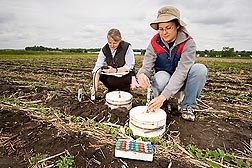Greenhouse Gas Emissions and Yields
from Organic and Conventional Systems
"Our human activities affect the environment, so agriculture is likely to leave a footprint," says Agricultural Research Service soil scientist Jane Johnson. “What we need to know is what we can do to reduce that footprint.”
As part of that goal, Johnson led a study to see whether reduced-tillage organic and conventional production systems differed in yields or in the emission of greenhouse gases that have greater global warming effects than carbon dioxide, like methane and nitrous oxide. That is, would greenhouse gas emissions from an acre of conventional corn exceed greenhouse gas emissions from an acre of organic corn, or vice versa?
Johnson works at the ARS North Central Soil Conservation Research Laboratory in Morris, Minnesota. Her project team included Morris soil scientist Sharon Weyers and biologist Nancy Barbour, as well as agricultural scientist David Archer, who works at the ARS Northern Great Plains Research Laboratory in Mandan, North Dakota.
The scientists studied yields from organic and conventional production of a 4-year corn-soybean-wheat-alfalfa rotation in Minnesota. While both systems relied primarily on alfalfa for nitrogen, the conventional plots were also amended with urea-based fertilizer, while the organically managed plots were amended with solid dairy manure. This meant that during the study period, the conventional systems received 590 pounds of synthetic nitrogen, almost twice as much as the organic systems received via dairy manure amendments.
The team used closed-vented chambers to monitor greenhouse gas emissions for 3 years during the growing season from May to November, as well as during early spring thaws. They found that both systems produced similar corn grain yields during 2007. But organic corn yields were 60 percent lower than conventional corn yields in 2006 and 40 percent lower during 2008.
During 2007 and 2008, organic and conventional soybean yields were similar, but 2006 organic soybean yields were 90 percent lower than conventional yields. In 2006, organic wheat yields were 50 percent lower than conventional wheat yields.
Field measurements of greenhouse gas emissions indicated that both systems emitted 3.75 pounds of nitrous oxide per acre every year—measurements that cumulatively represent 4.74 percent of the nitrogen added to the conventional system and 9.26 percent of the nitrogen added to the organic system. This meant that the nitrous oxide emissions per unit of nitrogen applied were nearly twice as large from the organically managed system as from the conventionally managed system.
The scientists believe that the greater biomass production in the conventional system and the lower productivity of the organic system indicate that the conventional crops were able to use applied nitrogen more effectively to support plant growth. Because the yield was lower from the organic system, the nitrous oxide footprint per unit of crop yield was greater in the organic system than in the conventional system.
“This study suggests that the ability of organic production to mitigate greenhouse gases may be less attractive to producers if it also results in lower yields. This emphasizes the importance of management to maintain crop productivity in any system,” Johnson says.—By Ann Perry, Agricultural Research Service Information Staff.
This research is part of Climate Change, Soils, and Emissions, an ARS national program (#212) described at www.nps.ars.usda.gov.
Jane Johnson is with the USDA-ARS North Central Soil Conservation Research Laboratory, 803 Iowa Ave., Morris, MN 56267; (320) 589-3411 ext. 131.
"Greenhouse Gases and Yields from Organic and Conventional Systems" was published in the November/December 2013 issue of Agricultural Research magazine.







